by Tom Gaylord
Writing as B.B. Pelletier

Johnson Indoor Target Gun was an impractical post-war BB gun.
This report covers:
- Sometimes you just can’t win!
- Johnson gets shafted
- The first time
- After the war
- Enter the Johnson Indoor Target Gun
- Repeater
- It uses surgical tubing
- Weird cocking!
- How much power?
- The cost
- Do you want one?
Sometimes you just can’t win!
Melvin Johnson was a gun designer of note who left a lasting impression on the world of firearms. Today’s M16/AR15 and all of its variants owe their existence to his marketing attempts with the United States Army. He did not design the gun — that credit belongs to Eugene Stoner. Johnson was the man who convinced the Army that a .22 caliber bullet flying at high velocity was better than a .30 caliber bullet in many ways. It was smaller, lighter, cheaper to make, flew faster and, under certain circumstances, was just as lethal as the larger projectile.
Johnson gets shafted
Johnson demonstrated his invention to the Army in the early 1950s. He called it the 5.7mm MMJ (Melvin M. Johnson — what else?). But later, when the cartridge became a semi-commercial product, it was given the name 5.7mm Johnson Spitfire. Johnson took a .30 caliber M1 Carbine cartridge case and necked it down to accept a .22 caliber bullet. This he fired in an M1 Carbine that had been rebarreled to the caliber. Though the case is small, it was capable of accelerating a lightweight .22 bullet up to around 3000 f.p.s., where it was quite lethal on human-sized animals.
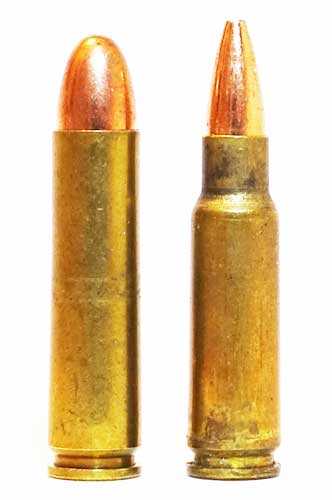
Johnson necked the .30 Carbine cartridge (left) down to .22 to create the 5.7mm MMJ.
The Army listened to what Col. Johnson had to say, then disregarded him entirely and set off on a campaign of their own to create a .22 caliber battle cartridge. They asked Remington to increase the powder capacity of their .222 caliber centerfire round to get higher velocity, which they did, calling it the .222 Remington Magnum. The Army rejected that cartridge, too, because its overall length was slightly too long to function in the new action that Stoner had developed. So they specified a slightly shorter cartridge that was called the 5.56mm. Remington was given the right to develop a commercial version of the round that they designated the .223 Remington, and the rest is history.
The first time
This wasn’t the first time Col. Johnson, a Marine Corps reservist, had suffered discouragement at the hands of the Army. In World War II he developed the Johnson Automatic Rifle — a semiautomatic rifle chambered for the M1 round we now call the 30-06. The Garand was the official military rifle at the time, but it was undergoing early development problems and wasn’t being produced fast enough to arm the troops going into battle, so Johnson’s rifle was procured in limited quantities as a stopgap measure. Marines that used them praised the Johnson rifles, even though they weren’t very successful with a bayonet (the barrel moved backwards when pressed from the front) that was considered essential in the Pacific Theater where they were used.
After the war
Melvin Johnson knew what it was like to have a good product that he couldn’t sell. After the war ended he continued to manufacture his automatic rifle, making slight changes and calling it a sporter, to appeal to the civilian market. One of its best features was the ability to make rapid barrel changes, which meant calibers could be switched in seconds — as long as the new cartridge was close to the same length and diameter as the one it replaced — a .270 Winchester and a 30-06, for instance. Wonderful concept, but not that practical. Switching calibers that are so similar in performance offers little advantage. So the popularity of the Johnson Sporter languished.
Enter the Johnson Indoor Target Gun
In 1948 Johnson came out with the Indoor Target Gun — a catapult gun housed in a plastic shell that resembled a submachine gun. Just as retailers push the black rifle look today, the submachine gun was thought to be a popular look in the post-war U.S. economy.
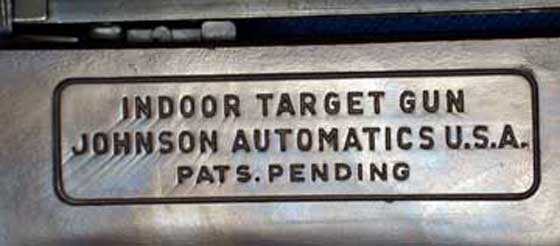
Gun is embossed with information on the plastic frame.
Here are just a few highlights about the gun’s design. The rear sight is a peep that slides up and down a slotted post for elevation adjustment. The front is a windage-adjustable post – just like several military rifles! The “ears” that protect the front sight are spring retainers that allow the top cover to be lifted. That gives access to the mechanism. The gun is a repeater! A long tube of real steel BBs feeds one at a time into the plastic shot carrier for launch. The trigger would embarrass half the adult airguns on today’s market – it’s that good.
Repeater
The gun is a repeater! A long tube of real steel BBs feeds one at a time into the plastic shot carrier for launch. When the carrier is pulled back to cock the gun it trips the magazine gate to open and deposit a single BB into the carrier. When the sear breaks it releases the carrier to fly forward and fling the BB out the end of the gun — there is no barrel.
The Johnson gun is a fascinating study in the toymaker’s art of the 1940s. The materials used were stamped steel plate and plastic. The steel parts were mostly well-finished with black oxide (bluing). Though plastics were in their infancy in those days, Johnson apparently picked the right ones because they don’t deteriorate nearly as much as the early Daisy plastic stocks.
For power a Johnson needs something with a lot more power than rubber bands. Medical rubber tubing is perfect. Of course this tubing wears out from repeated stretching, so owners have to replace it periodically. Below I show the installation on my gun, in case you have to do the job.
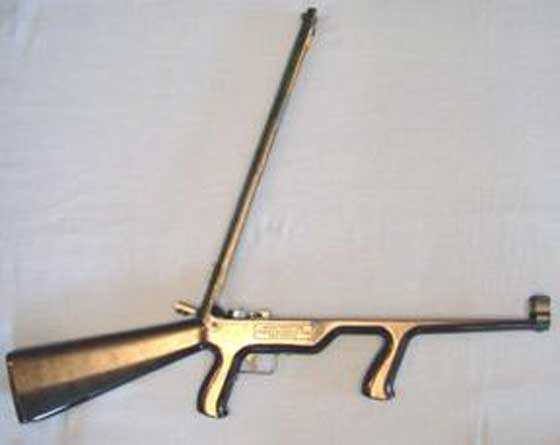
Lift the top cover to expose the surgical tubing that launches the BBs. Also to load the BB magazine.
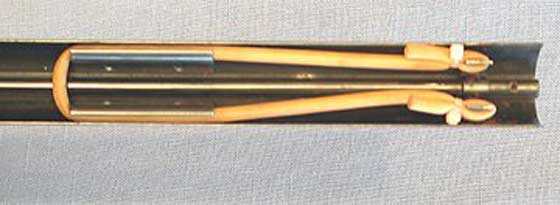
The underside of the metal cover is where the surgical tubing lives, and also the BB magazine.
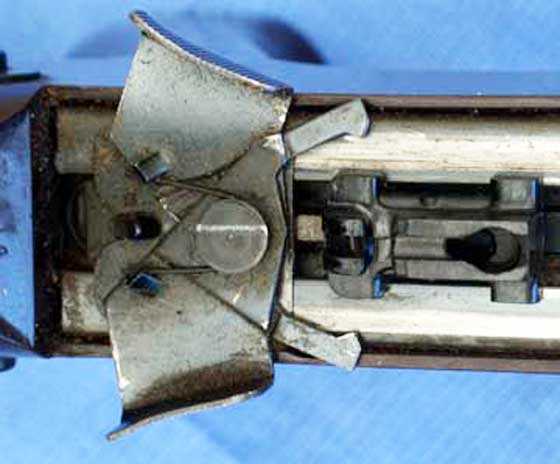
The cocking mechanism lives inside the bottom half of the gun. Your fingers pinch those hooks to grab the BB carrier and pull it back to the sear while it drags the rubber band along for the ride.
Weird cocking!
To cock and load, a pair of metal fingers at the “breech” are squeezed together and pulled backward, pulling a plastic launcher in front of them. A groove in the launcher captures the rear of the rubber band and as the entire mechanism now slides to the rear the sear catches it with a click. As it passes a metal release lever in the magazine, one BB is dropped into the launcher seat.
How much power?
Velocity depends on the strength of the rubber band. It never varies by more than two f.p.s., which makes it even more stable than an airgun. The gun was made during a time when accuracy was favored over power. My Johnson gets 101 f.p.s. with steel BBs. While that is very slow, I can pick off a fly at 12 feet, which is what this gun was designed to do. Velocity varies by no more than 2 f.p.s. Accuracy lets you hit baby asprin at 10 feet with every shot! Of course, 100 f.p.s. isn’t much, but the scale of the target gallery is perfect for it.
The cost?
Brand new in 1949, a Johnson sold for $15 – when a Daisy number 25 pump gun was selling for just $6.50. That probably aided the demise of the Johnson. His automatic rifles were too different from the Garand to gain success and his Indoor Target Gun was too expensive.
Today, you can find a complete and functioning gun at an airgun show for $50 to $75. A good one in a tattered box brings $100 to 150. The Blue Book lists them for $25 to $115, plus another $30 for the box. All the boxes will be tattered because they are made from pasteboard that contains acid. They have been disintegrating for the past 65 years and it is now impossible to find one in good condition. They are all crumbling into a fine powder, but hey, who isn’t?
The box turned into a shooting gallery with metal spinners on a wire stand that connected to the box. The cheesecloth hung behind to stop the shots. There was also a small bundle of replacement rubber bands.
The BB carrier is made from plastic and the one on my gun has worn through, so it can’t be pulled back by the finger tabs any longer. But I discovered that I can run a heavy dowel into the front of the gun and push the carrier into the cocked position, so my gun still shoots — some of the time. It’s fiddly but it can be made to work.
Do you want one?
The Johnson is a very specialized BB gun for the collector who cannot live without it. I grew up seeing them in ads, so when they became available at airgun shows, I had to get one. But for the guy with a hankering for a really accurate BB gun, my recommendation will always be the Daisy Avanti 499.
A Johnson is a curiosity among BB guns — like a Stanley Steamer is to car buffs. It’s weird enough to stimulate the collector, but aggravate a serious shooter.

In the section “Enter the Johnson Indoor Target Gun” is there supposed to be an image to go along with the caption?
12-28-15-03-writing
Gun is embossed with information on the plastic frame.
I would suppose there ought to be one probably the second image of your article: /blog/2005/12/johnson-indoor-target-gun/
Siraniko,
Good eye. I fixed it.
B.B.
Hi BB and the group.
Looking at your excellent photography of the Johnson, I am impressed with the mechanics of the bb holder. I think the physics involved with air guns, pistols, rifles etc helps make this hobby so interesting . I am not in the collecting stage yet but the information you post sure aids me in understanding more about the various guns that are out there. BB, I have a problem with my vision. Most of my pistol’s front sight is just a blur. I have had contact surgery on both eyes and currently wear bi-focals. It seems like in one of your past posts you suggested using reading glasses to better see the front sight. Am I connect ? and if so how strong should they be. Best wishes Harvey in frozen western Idaho.
K7uqshooter,
Yes. When my undiagnosed Diabetes had caused me to dehydrate, I wore reading glasses to see the front sight. I wear a 1.75 correction now, but during that time I had to wear a 2.50 correction. It did work well. It took me 6 months to rehydrate after I started taking insulin.
B.B.
K7ugshooter
I have a pair of progressive lense glasses. I don’t normally use them. I could not get use to them. I tried them the other day with open sites. They worked pretty good. I can pick a magnification that gives the best focus for both sites and the target.
Good luck
Don
Thank you Don, Next time I am due for a eye exam I will enquire about them.
Shoot safe, Harvey
The surgery should have read cataract surgery. Thanks again.
Harvey
Hello again and thank you for the information on reading glasses. The group of guys I shoot with normally shoot 3″ sight n c reactive targets at ten meters. Many of my pistols have black sights. Black sights on black targets is kind of a bummer. I have tried the red dot sights on some of the pistols and most of the dots are too bright even on the lowest setting. Also I do not like the added weight of the optical sight. I am going to try reading glasses, practice a six O clock hold on the target, where I can see a little daylight under the target and of course adjust for elevation to get me in the black. Forgive me for bending your ear, but pretty quiet morning here. In your opinion is the Gamo Compact easier to hold and shoot then the Webley Alecto ? Thanks again.
Harvey
K7uqshooter,
Yes, in my opinion the Gamo Compact is easier to hold than the Webley Alecto.
B.B.
Any comment on red dots being too bright? I picked up a cheap one and can basically only see a big mess of red reflection. Do they have to be a good few bucks to work well? Are enclosed point sights different?
RDNA,
It’s not the intensity of the light. It’s the cheapness of the optics.
Spend a little more money — just like with scopes and airguns. I trust the UTG brand and the BSA brand also seems to be good.
B.B.
Any reason not to have a new carrier 3d printed? Is it very complicated to model?
Does not look very large.
Steven,
No I have though of doing that. Unfortunately one of the cocking hooks finally broke off my gun, so I will never be able to cock it normally again. But there are probably plenty of them that could use a new carrier.
B.B.
BB—-I had a Johnson 30, 06 rifle back in the 1960,s. Compared to my M1 and 1903,s, it was clumsy. It was not very accurate. The few that my friends had were also inaccurate ( including one with Venezuelan markings in 7×57). If you fired the NRA match with it, the metal hand guard (above the wood) got hot enough to burn your hand. Worst of all, the trigger had a rebound slap that caused your finger to go numb after a few shots. The barrel change and the magazine top off were its best features. Also, it did not go pingggg sifter the last shot. Johnson did not have a very long time to perfect this rifle. Given enough time , he could have made a better rifle, but the war had already started and the M1 was in production. The marines that praised it were probably comparing it to the 1903 , and would like any RELIABLE semi- automatic rifle that would give them more fire power than the 1903. Ed
Ed,
You are the only person I have ever heard of who has shot a Johnson. I had a chance to buy one in .270 Winchester in the 1970s, but it was $400 and I just didn’t have the money.
Glad now that I didn’t do it.
B.B.
I too owned a Johnson 30 in about 1951/2. I loved it. Our basement had a fireplace that was never used. An old rug made a great backstop for BB’s. It was so accurate that either me or my dad could light a self striking match by shooting off the tip. Wish I still had it. Can’t shoot nearly as well with my Crosman 2240 or my Duke Colt.
B.B.,
“They are all crumbling into a fine powder, but hey, who isn’t?” I laughed so loudly my wife had to know what I had just read!
Michael
Woke up to about 3″ of snow this morning, it’s supposed to be sunny by 5:00 but staying in the 30’s until overnight in the 20’s and teens. Gonna be a mess tomorrow!
K7,
I like to use Shoot-n-C targets and have the same black-on-black problem you do. How I solved it was painting the back of the front sight post white.
Most of my rifles have telescopic scopes.
Les
Good Idea. I have some of mine painted with yellow fingernail polish. Due to my vision problems, the yellow seems to glare too much and again the sight gets fuzzy. One of the easiest to see sights I have is the tactical white dot sights on my Colt Commander BB pistol. Wish I could get a similar sights for my Umarex Colt 1911 A1 pellet pistol. The all black sights on that thing are terrible for me to use. Thanks for your reply.
K7ugshooter,
I can relate with the vision issues. I have a 92FS and even painted the front and rear sights real, real nice, Two colors. No matter what I try, they do not work for me. A laser works perfect. I would get the Dan Wesson 715, 100%, hands down, for sure,.. that BB is currently reviewing but it has no optics mounting except for a silver muzzle add on that cost 50$. The gun is black/grey. I like the rear load cartridge. None of the others suit my taste for a pellet revolver. I say, skip the cartridges and do the circular clips like the 92FS has. Good luck.
Hi Chris. I will have to check out the Dan Wesson 715. I have several Umarex pistols with the 8 shot circular clips. Also the Crosman Vigilante. One of the last pistols I got was the Smith and Wesson Trr8 bb revolver. It uses the cartridges and seems quite accurate for what it is. So many guns, so little money !
Thank you and Happy New Year .
BB— I dry fired my Johnson almost every day for the 3 @ years that I had it. I took it to the Blue Trail range ( Wallingford Conn.) along with my M1 and 03,s (and shot it) twice/ month. After shooting it (and the dry fire sessions) my M1 felt like a carbine, by comparison. I never shot it in a match, but my friend did. He was shooting from the point to my left. In one match (, timed fire, seating pos.) the empty case from his first shot hit me in the neck and SLOOOWLY slid down my back! The Johnson ejects cases while they very hot. I knew that I could not call an alibi, so I had to keep shooting. I was lucky, the temp. was in the 90,s, and was only wearing my cloth shooting jacket. However , I was covered with sweat, And I only got a superficial burn. The rest of the cartridge cases just bounced off my jacket, leaving little dents in my skin. My friend got his dcm 1903A3 before the next match, and I traded the Johnson for a nib S&W 41. (I still have it). I wonder how many marines were pelted by ejected cases from the Johnson? Ed
BB,
Yesterday I went skeet shooting with my son-in-law Dean and my grandson Nicky. I am not much of a shotgun guy.
Hadn’t fired a shotgun since 1970, and hadn’t shot skeet since 1962. We were using 12 ga. pump guns.
I could only hit on average, one clay out of five. I had a problem maybe you can help me with. I shot about 50 rounds. My shoulder did not get sore, but my trigger finger was getting bruised. Every time I shot the trigger guard would impact against my trigger finger. Finally, I resorted to shoot wearing gloves.
What was I doing wrong? I don’t think this is normal.
Les
Les,
You are asking the world’s worst shotgun shot for advice with a scattergun? My advice is don’t use them.
Seriously, I can only hit things when I shoot a Browning A5 20 gauge that my buddy, Otho, refuses to sell me.
B.B.
Pump guns can be tricky especially if they’re too big for you, be sure to keep it firmly planted on your shoulder.
12ga pump guns are a bit long for me and I really loved my 16ga.
Happy Holidays Les,
I’ve put a few rounds through shotguns and would like to help if I can. Not sure I completely understand your issues though.
Only hitting one out of five clays is a long subject to address.
Your trigger finger getting impacted by the trigger guard? Do you mean that during the recoil the front of the trigger guard was hitting your trigger finger? In other words, your shooting hand slipped off the wrist or pistol grip on the stock and therefore your finger was constantly hit by the trigger guard?
kevin
Thanks, Kevin.
Yes, that was what was happening. I was trying hard to keep the stock tight against my shoulder. The inside of the trigger guard was slamming against my finger. Thinking about it now, my hand must have been slipping off the wrist of the stock. I wasn’t really thinking about that at the time, my concentration was on the target. I’ll pay more attention to that next time.
One out of five. Ten out of fifty. I was having a hard time judging my lead distance. I think most of the time I was leading the target too far. Just need more time to get used to the speed of the target and the speed of the shot column.
Les
Les,
With a pump it’s easy to get back into a more upright stance after racking the next shell. Lean back into the shot to mitigate recoil and minimize the chance of your shooting hand coming off of the stock during the shot. Proper stance can also help.
Leading targets just takes a few more outings to re-learn but follow through after pulling the shot takes longer. Too many shot gunners forget to continue their follow through after pulling the trigger.
Great to hear you’ve found a good reason to spend time with your grandson and son in law. Some folks never find these opportunities to grow with one another. Good for you.
kevin
Desertsweller
Hi, You might try a slip-on recoil pad if your stock is a little short. Also, if you’re shooting on a formal skeet range and can arrange it, shoot first the low house from Station 7 over and over until you get the idea of lead and some confidence. Then shoot high house from 7 for a while. Then do the same from station 1. Finally shoot some from Station 4. Shooting a complete rounds takes a long time to show improvement since the stations are so different–which makes skeet fun.
Three general rules: keep your head down on the stock, keep the gun swinging, lead everything 2-3 feet.
Good luck.
Fido3030
Desertdweller
Sorry I mis spelled your name
Fido3030